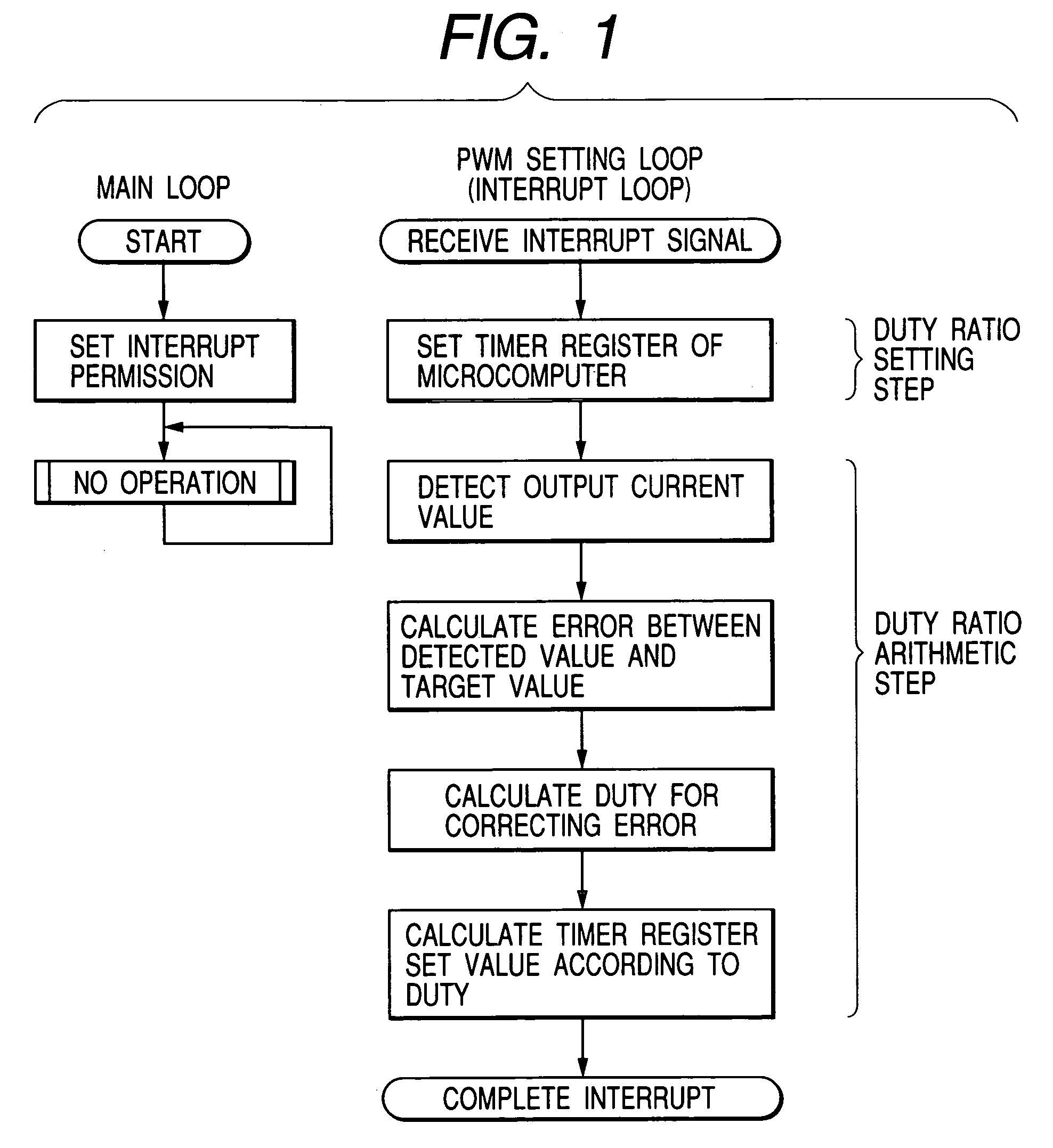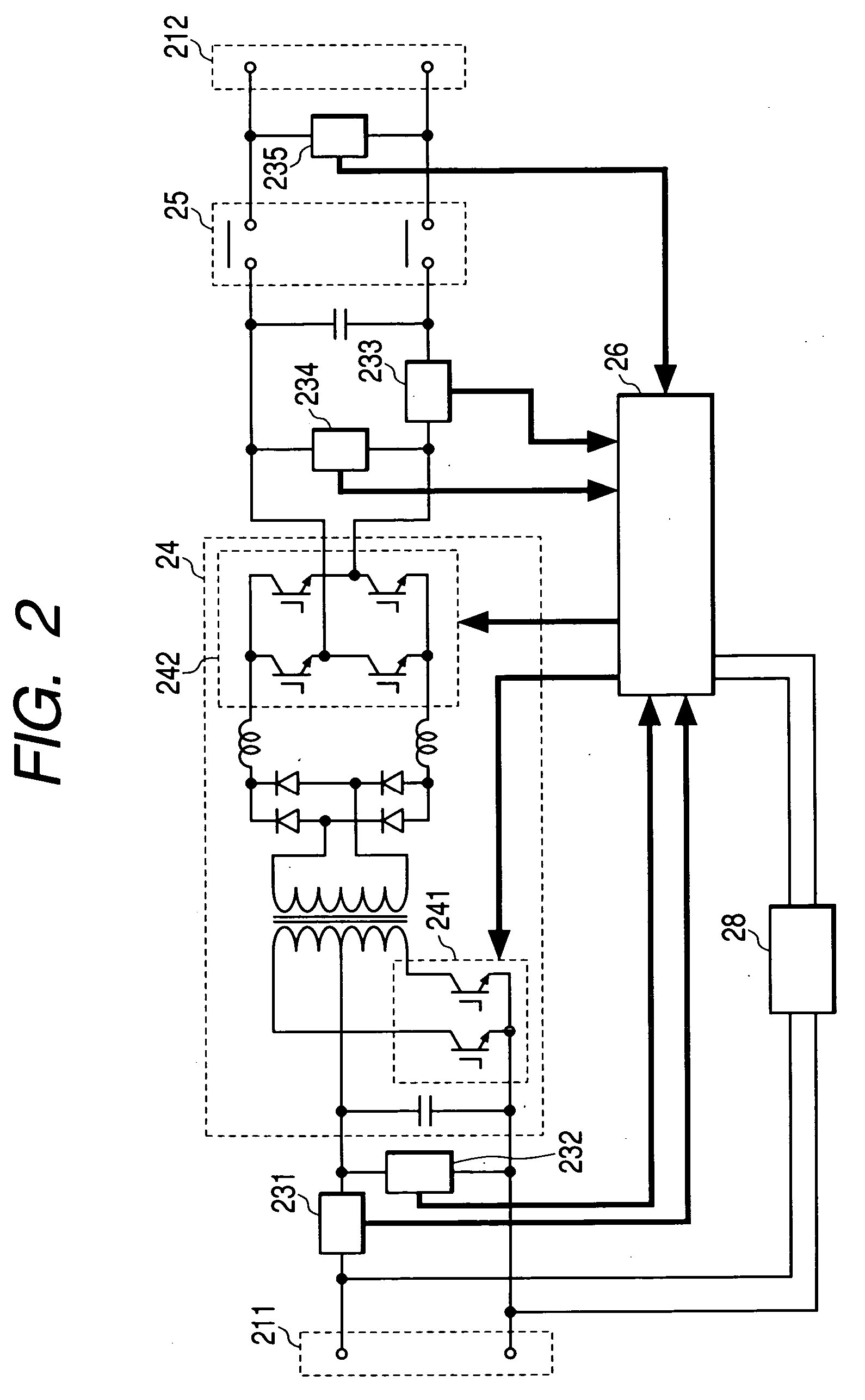Method of controlling signal generator
a signal generator and signal technology, applied in the direction of generating/distributing signals, process and machine control, etc., can solve the problems of high processing speed of microcomputers, serious problems such as biased magnetization, and increase the number of arithmetic in microcomputers, so as to achieve low operating frequency and achieve the effect of reducing efficiency
- Summary
- Abstract
- Description
- Claims
- Application Information
AI Technical Summary
Benefits of technology
Problems solved by technology
Method used
Image
Examples
embodiment 1
(Internal Structure of Power Converter)
[0051]FIG. 2 shows the structure of a power converter using a signal generator of the present invention. Reference numeral 211 denotes an input terminal for inputting a direct-current power from a solar cell and reference numeral 212 denotes an output terminal for outputting a power having been converted to alternating current power to a system and an alternating load. Reference numeral 24 denotes a DC / AC converter circuit constituted of a smoothing capacitor, a reactor, a switching element and so on. Reference numeral 25 denotes an interconnection relay for opening and closing an alternating output, reference numeral 232 denotes an input voltage detector for detecting voltage inputted from the input terminal, reference numeral 231 denotes an input current detector for detecting inputted current, reference numeral 234 denotes an output voltage detector for detecting voltage which is subjected to DC / AC conversion by the DC / AC converter circuit a...
embodiment 2
[0066]Embodiment 2 of the present invention will be discussed below.
[0067]Since the internal structure and the control circuit of a power converter are the same as Embodiment 1, the following will only discuss a method of controlling a push-pull section.
(Controlling Method)
[0068]PWM control on the push-pull section is performed according to the flow of FIG. 10.
[0069]A loop for setting writing (PWM setting loop) on a timer register for controlling the push-pull section is started when an interrupting signal is inputted to a microcomputer. In this example, the values of TIMR2 and TIMR4 are fixed and the values of TIMR1 and TIMR3 are changed so as to generate a PWM control waveform. Then, only for the set value of TIMR1, a set value is used which is determined in an interrupting step before a predetermined period. A detailed flow will be discussed below.
[0070]First, an instantaneous current detection value is read which has been converted to digital data by an AD converter in the micro...
embodiment 3
[0074]Embodiment 3 of the present invention will be discussed below.
[0075]Since the internal structure and the control circuit of a power converter are the same as Embodiments 1 and 2, the following will only discuss a method of controlling a push-pull section.
(Controlling Method)
[0076]Embodiments 1 and 2 used PWM control for controlling a pulse width. The present embodiment will be described using FM control shown in FIG. 12, in which a frequency is controlled with a constant pulse width.
[0077]Since PWM control has a constant switching frequency, TIMR2 and TIMR4 of time registers have constant values all the time and only the values of TIMR1 and TIMR3 are changed, so that a pulse width is controlled. However, since a switching frequency is changed in FM control, it is necessary to rewrite all the values of the four timer registers. Thus, as compared with PWM control, time required for rewriting on the timer registers is nearly twice.
[0078]The following explanation will be made with...
PUM
 Login to View More
Login to View More Abstract
Description
Claims
Application Information
 Login to View More
Login to View More - R&D
- Intellectual Property
- Life Sciences
- Materials
- Tech Scout
- Unparalleled Data Quality
- Higher Quality Content
- 60% Fewer Hallucinations
Browse by: Latest US Patents, China's latest patents, Technical Efficacy Thesaurus, Application Domain, Technology Topic, Popular Technical Reports.
© 2025 PatSnap. All rights reserved.Legal|Privacy policy|Modern Slavery Act Transparency Statement|Sitemap|About US| Contact US: help@patsnap.com



